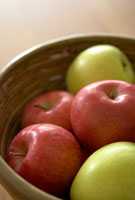Eat Right!
 Learning how to eat right is an important part of controlling your diabetes. This section will provide tips on healthy eating, weight control, recipes and special diets. Remember, eating healthy is not just for people with diabetes.
Learning how to eat right is an important part of controlling your diabetes. This section will provide tips on healthy eating, weight control, recipes and special diets. Remember, eating healthy is not just for people with diabetes.
What healthy food choices should I make?
Eat smaller portions. Learn what a serving size is for different foods and how many servings you need in a meal.
Eat less fat. Choose fewer high-fat foods and use less fat for cooking. You especially want to limit foods that are high in saturated fats or trans fat, such as:
- Fatty cuts of meat.
- Fried Foods
- Whole milk and dairy products made from whole milk.
- Cakes, candy, cookies, crackers, and pies.
- Salad dressings.
- Lard, shortening, stick margarine, and nondairy creamers.
Talk to your health care provider and take this tip sheet [PDF-253KB] with you to find out more.
What should I eat more of?

Eat more fiber by eating more whole-grain foods. Whole grains can be found in:
- Breakfast cereals made with 100% whole grains.
- Oatmeal.
- Whole grain rice.
- Whole-wheat bread, bagels, pita bread, and tortillas.
Eat a variety of fruits and vegetables every day. Choose fresh, frozen, canned, or dried fruit and 100% fruit juices most of the time. Eat plenty of veggies like these:
- Dark green veggies (e.g., broccoli, spinach, brussels sprouts).
- Orange veggies (e.g., carrots, sweet potatoes, pumpkin, winter squash).
- Beans and peas (e.g., black beans, garbanzo beans, kidney beans, pinto beans, split peas, lentils).
What should I eat less of?
Eat fewer foods that are high in sugar, such as: 
- Fruit-flavored drinks.
- Sodas.
- Tea or coffee sweetened with sugar.
Use less salt in cooking and at the table. Eat fewer foods that are high in salt, such as:
- Canned and package soups.
- Canned vegetables.
- Pickles.
- Processed meats.
Where can I learn about making a diabetes meal plan?
- Contact a registered dietitian to make a meal plan just for you.
- Visit the Academy of Nutrition and Dietetics, formerly the American Dietetic Association Web site to find a nutrition professional that can help you develop a healthy meal plan (www.eatright.org).
- Visit the American Association of Diabetes Educators to find a diabetes educator (www.diabeteseducator.org).
- Visit the American Diabetes Association Web site for more information on carbohydrate counting and the exchange method (www.diabetes.org).
Are there recipes available for people with diabetes or prediabetes?
From the National Diabetes Education Program
-
Tasty Recipes for People with Diabetes and Their Families [PDF-1.01MB]
Also available in Spanish [PDF-1.36MB]
From the National Diabetes Information Clearinghouse
-
“What I need to know about eating and diabetes”
Also available in Spanish
From MedlinePlus
What are some healthy eating options for people who don’t have diabetes?
From the Centers for Disease Control and Prevention (CDC)
From the Department of Health and Human Services (HHS) and the Department of Agriculture (USDA)
From the U.S. Food and Drug Administration (FDA)
From the Food and Nutrition Information Center of the U.S. Department of Agriculture (USDA)
From MedlinePlus
-
Nutrition
Also available in Spanish -
Nutrition for children
Also available in Spanish -
Nutrition for seniors
Also available in Spanish
From Healthfinder®—Office of Disease Prevention and Health Promotion, U.S. Department of Health and Human Services
From the Produce for Better Health Foundation
From the Academy of Nutrition and Dietetics, formerly the American Dietetic Association
- Page last reviewed: April 15, 2016
- Page last updated: April 15, 2016
- Content source:
- Maintained By:
- National Center for Chronic Disease Prevention and Health Promotion, Division of Diabetes Translation


 ShareCompartir
ShareCompartir